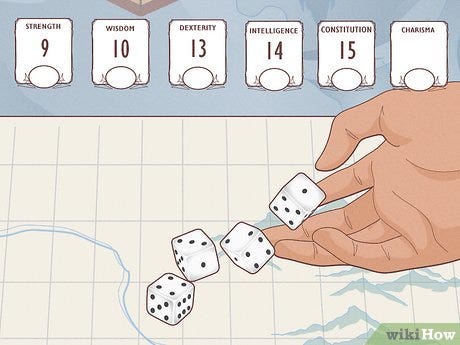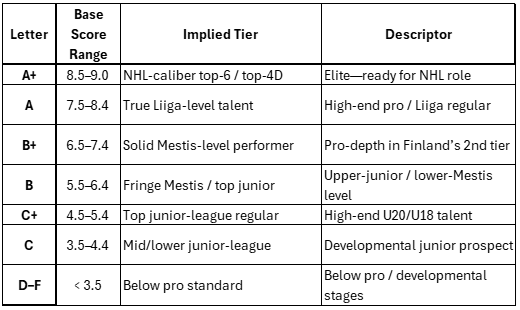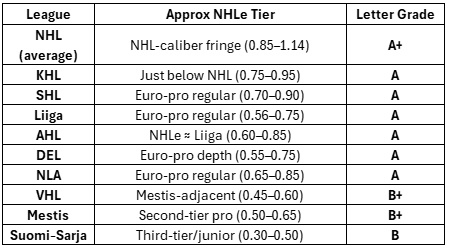Finding a System: A Starting Place on the Road to Developing as a Scout
Developing a Ranking System to use for Finnish Prospect Scouting
In Dungeons & Dragons, a character’s stats are based on and represented by ability scores. If you’ve played any pop-culture role-playing video game or tabletop game, you’re familiar with the classic system: Strength, Wisdom, Dexterity, Intelligence, Constitution, and Charisma. Game designers use these broad categories—or similar ones—as a starting point for every ability needed to be an adventurer, dungeon crawler, or courier through the Mojave Wasteland.
Similarly, hockey scouts and prospect analysts use a comparable system to give readers—and themselves—a clear basis for what makes a good hockey player. These categories describe the aspects of a complete-package player. Miro Heiskanen is a great hockey player, but that alone doesn’t tell you how good Heiskanen is. Even calling him a great defenseman doesn’t quite capture what convinced Jim Nill in 2017 to use the third overall pick on him.
A more detailed breakdown of his skills was needed to carry that message. Professional scouts could most likely write a thesis on why Heiskanen excels, but audiences often want a quicker, snappier overview that shows how Heiskanen shines in a 30-second glance at his profile.
I’m sure hockey scouts didn’t steal the idea from Gary Gygax and Dave Arneson’s Dungeons & Dragons, but the comparison works. In most modern scouting reports, you’ll see a similar “hockey ability-score” list.
Examples:
Skating
Stickhandling
Shooting
Passing
Physicality
Vision
I’m new to the world of scouting, and to make sure the content I present is as strong as possible, I sought advice from Brock Otten, Director of Scouting at McKeen’s Hockey. One piece of feedback on my first article was to develop clear categories for organizing reports. That brings me to today’s topic: creating a system I can use across all reports to give my readers a consistent 30-second impression of each player.
Six “Prospect” Categories
Similar to the ability scores used in D&D, I’ve developed a grouping of categories that together define a complete skater. I leaned on one of the great prospecting companies (Elite Prospects) and adopted some of their classifications. Below, I’ll flesh out each category and what it covers:
Skating: Speed, acceleration, edges, balance, agility
Shooting: Release quickness, accuracy, power, shot variety
Passing: First-pass vision, accuracy, creativity in tight spots
Handling: Puck control under pressure—stickwork, protection, dekes
Sense: Hockey IQ—positioning, anticipation, play recognition
Physical: Competitiveness, board battles, gap-control (D), willingness to engage
Each of these Categories will be graded on a 1-9 scale.
Numeric Scale Guide
For those who prefer more detail than simply “1 = Bad” or “9 = Good,” here are the definitions:
1.0–2.5 Well below pro standard
3.0–4.5 Fringe junior-level tool
5.0–6.5 Meets pro benchmarks occasionally
7.0–8.5 Well above average for the league
9.0 Elite / top-5% in the league
Weighting & Base Score
Not all skills are equally important at every position. For example, a strong Physical game matters more for a defenseman than for a forward. By applying position-specific weights, we can compute a weighted average to gauge a player’s overall performance.
Letter Grades & League Tiers
Once you’ve calculated an overall player score, you can convert it to a letter grade. As you may recall from my previous article, there are various adult and junior leagues represented across the scoring spectrum. I wanted this grading scale to reflect those differences—so, for example, earning a C+ in a U16 league is actually very impressive at that level.
This system lets me reassess a player over time, tracking whether their score—and thus their letter grade—is improving relative to the league they’re aiming for.
Example Player A
Skill Grades (1–9)
Skating: 7.0
Shooting: 7.5
Passing: 8.0
Handling: 7.5
Sense: 8.0
Physical: 6.5
Compute Base Score
So, Player A would receive a letter grade of A, placing him among high-end Liiga talent.
Tangent: Performance Across Leagues
I’m a big fan of data-driven metrics that measure player performance across leagues. The NHL firmly sits at the top of the professional hockey food chain, and there’s always lively discussion when you start comparing players from various adult leagues around the world. This naturally leads to fascinating research into NHL equivalency (NHLe) models—a metric used to estimate how a player’s point production in other leagues might translate to the NHL. For fun, I applied several NHLe models to see where the average player in each league would rank in my scoring system.
With this, you can see that a C+ prospect—considered a top-level talent at the U18/U20 level—would begin to be ready to cross the threshold into Suomi-Sarja (Finland’s third-tier adult division) and Mestis (the second-tier adult division) in terms of development.
Two great articles for further NHLe readings and sources: [1] and [2]
Wrap Up
Going forward, I believe this framework provides a solid foundation for evaluating and measuring talent. As I grow as a scout, this system will likely evolve, and I’ll be sure to keep readers updated!
If you have any more questions, feel free to reach out to me via email or find me on X.
Email: AndrewPEpps@yahoo.com
X: https://x.com/epps_andrew








